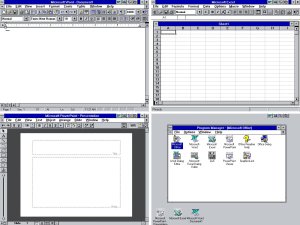The impact of technology in education in the years 1985-1990
Our generation has been a witness of enormous advances in technology. Today we have a wide range of technological resources available to us to facilitate the recollection of information, the connection with our peers, and overall, our learning. However, this was not always the case. Technology has evolved, and we will analyze the impact that it has made on education from the years 1985 to 2005.
To begin, as technology grew and develop, so did the number of people that opposed it and the number of people that supported it. In an article by professors Richard Halverson and Annette Smith it is stated that “enthusiasts such as Seymour Papert (1980) predicted that computers would allow learners to construct and test hypotheses about complex systems.” The same man, Papert, also stated that “computing would extend communication networks, provide immediate access to information, and facilitate new forms of creative expression.” And he was right.
In the early 80’s, the first personal computers were introduced. This was a major advancement in the computer industry with only IBM and Apple leading the competition. In 1980 IBM released its first PC and in 1984 Apple released the first generation Macintosh, which was the first computer to come with a graphical user interface (GUI) and a mouse. This allowed for regular people to be able to purchase a  com
com puter for themselves, instead of the use of computers staying amongst professionals. Later, in 1985, the CD-ROM was created which allowed the storage of entire encyclopedias, audio and even video and reduced the need for floppy disks. This was another step closer to modern storage devices and programs. Dell also released their first computer, the “Turbo PC”. Lastly 1985 was also the year in which the Texas Instruments TI 4100, the first handheld graphing calculator was introduced. As we can see, 1985 was a year of many technological inventions that were later introduced into education to enhance the gathering, storage, and analyzation of data.
puter for themselves, instead of the use of computers staying amongst professionals. Later, in 1985, the CD-ROM was created which allowed the storage of entire encyclopedias, audio and even video and reduced the need for floppy disks. This was another step closer to modern storage devices and programs. Dell also released their first computer, the “Turbo PC”. Lastly 1985 was also the year in which the Texas Instruments TI 4100, the first handheld graphing calculator was introduced. As we can see, 1985 was a year of many technological inventions that were later introduced into education to enhance the gathering, storage, and analyzation of data.
In 1986, IBM announces the launch of their first laptop computer. By this time there was more than 30 million computers in use in the United States.
In 1987, the Electronic Pocket Calculator was created, making mathematics a lot simpler for many students, by making these types of tools more accessible. Many programs were also developed such as Microsoft 1.0, Adobe Illustrator and the McAfee Company that developed antivirus programs, all which kept on evolving. Meanwhile, the improvement of former computers was in effect, and new software kept on revolutionizing the effectiveness in computers.
In 1988, Steve Jobs, while working independently of Apple, developed the NeXT computer, which eventually led him back to Apple to create more new and innovative software. Also, SanDisk was founded, which led to the development of flash drive storage. At the same time, computer software kept on improving.

In 1989, a major event occurred. The first Internet Service Provider known as “The World” made the internet available to the general public. This was a huge advancement because it meant that now everyone that had a computer could access the tons of information available through the web.
Overall, from 1985 to 1989, the United States and the world were witnesses of major inventions that gave way to the tremendously modern and effective machines and software we use today. Not much is documented about the effects that these had on education, except for the fact that they enhanced the way of accessing information. This was mainly due to the fact that these inventions were fairly new, and many were skeptic about their effectiveness in school. Also, the prices on these new machines was very high, so many schools didn’t have a vast amount of technological resources until later on.
The early 90’s had a significant surge of technological advancements that have help within the world. These advancements range anywhere from the Hubble Space Telescope being launched into space to the creation of Doom the first, first person shooter 3-d video game being released worldwide. The course of technology within the world began to take shape in what it would be become today. But like all good stories you must first start from the beginning.

It was around the early February in 1990 and the Adobe releases its first version of Photoshop. Photoshop allows people to change and add things to a photo and at this time this was an amazing feat as it would allow for what we use today in the entertainment industry to make things and correct stuff that shouldn’t have been there. As a couple months progressed things moved toward an enormous and costly telescope that would be one of the shinning features that NASA has ever launched. This telescope allows for people to take pictures and view things that are millions miles away. New galaxies, stars and the unknown have all begun being documented by this enormous telescope over the last 25 years. As the early 90’s drew closer to a there were several key things that were released to the world. The first would be Microsoft Office that was released in October. This program allowed for people to use some of the things that we use today such as Microsoft office, excel, and PowerPoint. The programs allowed for people to do business oriented stuff with much more ease than before. The next thing would be the Super NES released by Nintendo in November. This new gaming system that was developed was far more superior compared to any of its competitors and thus was praised for its feats in technological advancements that can still be seen today such as the 16-bit processor.

As the next year would roll in more advancements would come in the first would be Aol being released in February 1991. As it was previously known as America Online, the system became one of the first email distributors that was used in the 90’s. Now the next thing that would revolutionize the market wouldn’t come till late August this new invention was Linux. Linux is a free OS system that was the main competitor of Microsoft because it was shifted toward lower end personal computers at the time and the fact that it was free. As 1991 would end and the New Year came in it would not be until September of 1992 came in that Apple would release the Appel Power Book. This was the one of the first variants of the Macbook that was ever developed. The Power Book was portable and offered the best technology to everyone at the time for those on the go.
Not much else was developed around this time and thus things slowed down until 1993 came around. The processor line that Intel developed became worldwide as we concurrently use the Central Processing Units. These little chips introduced a wider range of things that a computer could do and allowed for people to be able to actually use the computer in more ways than one. It was not until late 1993 that the most revolutionary game was released to the world. In December of 1993 Doom was released by id software as a change in the way that people looked and played games. It brought in a new genera of games that were 3-D. Additionally this game brought the amount first person shooters that are still being made today. The game managed to change the way that people played games in ways that had never been conceived.
When 1994 came into play the world had two important pieces of technology that were brought into the system. The first is the way that most people shop today, this new website was Amazon.com. While it was not always a shopping site at first it grew and became one of the largest shopping website today. Next would be the first internet browser known as Netscape Navigator which was released in December of 1994. This browser allowed for people to navigate the internet with ease hence the name and the specific purpose of the browser. With the close of 1994 and the rise of 1995 there were a large amount of technological achievements that were implemented. The first would be Java which is what almost everything runs on in a sense that computers were able to understand how a program worked and carry out the task. Several months later in ’95, Yahoo was released as means for people to navigate the web, email, and store things on a database for use later. In late August Windows 95 was released to the world sparking, sparking the OS system that was upgraded and used today.
Ebay which is one of the largest bidding website was released in September of 1995. Toward the end of September Toy Story was released, which used such a large amount of time and processing to make the movie fully rendered. During this time this was a large achievement that still surprised people today. A few days after toy story was released HMTL 2.0 came out. This new program added more attractiveness to website and was helpful for both developers and users. Lastly in 1995 the idea of the DVD was invented. This allowed for many educational videos, movies, and documentaries to be shown in schools.

Furthermore, ironically, for this research blog, the librarian told us to look up things on Journal Storage. Well, journal storage, also known as “JSTOR” was founded in 1995. This has been one of the most successful innovations of this era considering that over 50% of students in the United States use it as a credible source. Without this source we probably wouldn’t have half the information we are providing you right now.
A year after this was created, “macromedia flash 1.0” was invented. The question is- what exactly is the definition of this “flash”? Have you ever wanted to watch a video and your computer won’t let you because you have to update your adobe flash player? Well, macromedia is another name for adobe flash player. When these things were invented both required the Ethernet cable to be connected.

In 1997, everything changed. What we can’t possibly live today without what was created then, the “Wi-Fi”. This has been one of the things that has mostly helped evolve and develop our minds as well as our brains. With Wi-Fi becoming a phenomenon and computers beginning to be used for more advanced purposes, MP3 players were created in 1998 and people could download music online.
Speaking of computers, Apple revolutionized computers in ’98 by creating the very first iMac ever. In 1999, Larry page and Sergey Birn were both students in Stanford university wanting to change the world online and the Internet. Although they never truly expected what would happen. These two men are founders of Google and are now making over billions of year off of the search engine that is used by millions of students, professionals, and the general public all over the world.

Most of the creations in the ’90s were computer things, but what about the 21st century? Well, in the year 2000 the very first hybrid car was modified and sold. A hybrid car is a car with a gasoline engine and an electric motor, each of which can propel it. The very first car invented this way was made by Toyota. It was a first generation Toyota Prius. After this, evolution on cars has also advanced greatly. The impact of this innovation was the saving energy because it has a system that when the power of the moor was not required to move the vehicle, the motor can shut off, saving energy, or can be used to generate electricity that is stored in batteries, and later used to power the car. This really impact the technology and is still in use and very popular now a days although is not hat expensive as it were back in 2000´s.
Also, in the year 2002, camera phones were introduced. Around 80 million camera phones were sold in 2003 and they get to be even popular than the stand alone digital cameras.
Not only that, but in 2003 Steve Jobs created the iTunes program, which has evolved so much in the last couple of years and it is now a source not only for music, but for many videos, podcasts, and apps that can be used in the educational fields.

Finally, one of the most important technological innovations of this time was the creation of YouTube. This video sharing service has become one of the most visited sites in the world. It contains so many videos from a wide range of categories. One can basically find anything from educational and academic subjects, to everyday do-it-yourself tutorials and procedures. Today, any educators use YouTube to have a visual aid to go along with their lessons.
To conclude, technology has evolved so much in the last couple of years, and these changes have made an impact in education. The way that information is acquired, presented, and stored are definitely changing, making everything more accessible and faster. According to an article by the Sanford-Brown Institute in Boston, “When examining how education has changed, it is now apparent that online education has become part of mainstream teaching and learning, since students now have access to a wide range of increasingly impressive online resources.” These resources would not have been available to current students without all the previously mentioned technologies as their precedents.
References
Computer Hope. Computer history. Retrieved from http://www.computerhope.com/history/1989.htm
Curry, M. (2009). 2000 – 2009: A decade of technology innovation in review. Retrieved from http://www.michaelmccurry.net/2009/12/26/2000-2009-a-decade-of-technology-innovation-in-review/
Digital Preservation Management. (2013). Timeline: Digital technology and preservation. Retrieved from http://www.dpworkshop.org/dpm-eng/timeline/viewall.html
Education Week. (2011). Technology in education. Retrieved from http://www.edweek.org/ew/issues/technology-in-education/
Ellen R. Bialo, Jay Sivin – Kachala. (1996). The effectiveness of technology in schools: A summary of recent research. Retrieved from http://www.ala.org/aasl/sites/ala.org.aasl/files/content/aaslpubsandjournals/slr/edchoice/SLMQ_EffectivenessofTechnologyinSchools_InfoPower.pdf
Nguyen, G. (2013). Technology era 90s -95s. Retrieved from https://www.timetoast.com/timelines/technology-era-90s-95s
Simson.net. A short history of NeXT. Retrieved from http://simson.net/ref/NeXT/aboutnext.htm
Stanford-Brown. (2014). How education has changed with the rise of education. Retrieved from http://www.sanfordbrown.edu/student-life/blog/december-2014/how-education-has-changed-with-the-rise-of-technology
